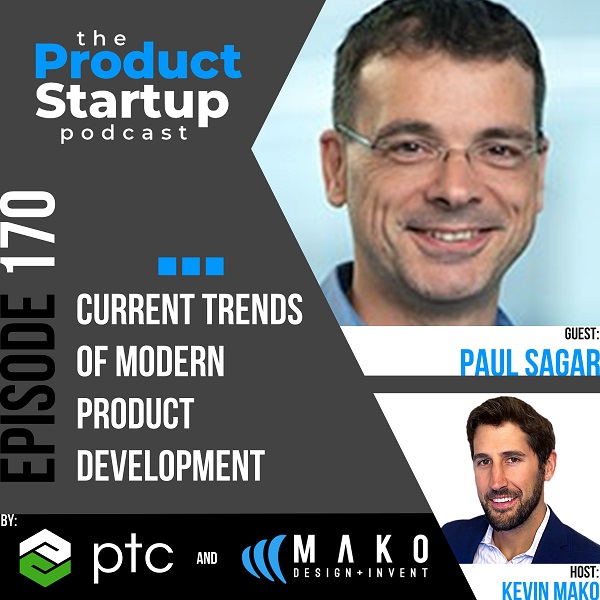With Paul Sagar, Vice President of Product Management at CREO
Hosted by Kevin Mako, President of MAKO Design + Invent

Paul Sagar, who began his career as a design engineer, currently serves as the Vice President of Product Management for PTC’s CREO software line. Over the last 25 years, he has been dedicated to developing CAD software tailored to the requirements of hardware design teams. In this session, Paul will impart some valuable insights to inventors, startups, and small-scale manufacturers on the latest trends in new product development for hardware startups. He will cover best practices in composite materials, the electrification of products, and additive manufacturing for initial manufacturing runs.
Today you will hear us talk about:
- The use of composite materials and design offers numerous benefits.
- More and more consumer product brands are integrating high-quality, costly composite materials into relatively straightforward products.
- Composite materials provide greater design flexibility while maintaining strength and quality with their lightweight properties.
- Incorporating composites into hardware product design can lead to increased sustainability.
- Historically, composites have been costly to purchase and manufacture, but accessibility is improving.
- With low-volume production capital costs being low, new product startup brands can focus on quality while producing in smaller quantities.
- The electrification of products is already underway and is a fundamental aspect of modern design.
- Design must increasingly incorporate electronics and electrification, with a focus on collaboration between electronics and mechanical engineering.
- Additive manufacturing is rapidly evolving, particularly in production design.
- While additive manufacturing was initially used for rapid prototyping, it is now commonly used for final part design, especially for first manufacturing runs.
- Short-run additive manufacturing offers advantages in terms of up-front capital costs and increased design options.
- Additive manufacturing facilitates faster production while maintaining quality and reducing up-front costs.
EPISODE HIGHLIGHTS
- 2:00 – Product Development and emerging product development trends.
- 4:00 – The first trend is the use of composite design.
- 4:30 – More people are using high-end composites now in regular consumer products to increase the quality of the product.
- 5:40 – Composite materials can actually be helpful in sustainable development as well.
- 6:10 – Composites can be cheaper upfront in manufacturing for the capital costs as tooling is relatively simple. Low volume cost is low overall.
- 7:15 – The tools inside CAD software is now starting to allow you to use these in the design and manufacturing of products.
- 8:45 – Quality is critical when it comes to manufacturing, so better materials allow for a higher quality of product for a first hardware product launch.
- 9:20 – As a hardware startup, very rarely are you focussed on making the cheapest product because you have a new innovation.
- 9:40 – You start being a lower-cost product much further into the mature stages of your product lifecycle.
- 10:00 – You can design the best product, but then you need to design for manufacturability, reliability, and quality.
- 10:30 – Almost all hardware startups begin at low-volume production.
- 11:10 – Eventually everything will have a computer chip in it, and most traditional combustion products will soon be electric.
- 13:20 – As you incorporate more electronics into product design, more electrical engineering and mechanical engineering has to be done in collaboration as opposed to linearly.
- 18:45 – Design for manufacturing after fully testing and perfecting the prototyping and engineering phases.
- 19:00 – Short-run manufacturing or low-volume manufacturing runs. Additive manufacturing.
- 19:30 – Additive manufacturing just used to be for prototype testing, but now it’s being used for actual final part manufacturing.
- 19:45 – More effective, quicker, and potentially cheaper.
- 20:00 – Tooling is an expensive and time-consuming process; whereas additive can do it much cheaper, especially at low volume.
- 20:30 – Performance of the part sometimes can even improve via the new abilities of additive manufacturing, making the product potentially even better than traditional tooling.
- 24:00 – At small volume, your tooling cost will be lower, but your unit cost will likely be higher; however, as a hardware startup the first run is primarily for customer feedback and market validation anyhow, so it works very well.
- 25:00 – Traditional manufacturing has a lot of rules about what you can actually design.
EPISODE LINKS
Paul Sagar Links:
LinkedIn | Creo | PTC | OnShape
The Product Startup Podcast Links:
https://www.ProductStartup.com/
Instagram | LinkedIn | Facebook Page | Facebook Group | Pinterest | Twitter | YouTube
PTC Links:
https://www.ptc.com/
OnShape | Creo
Mako Design Links:
https://www.makodesign.com/
YouTube | Instagram | LinkedIn | Facebook | Pinterest | Twitter
Kevin Mako Links:
Instagram | LinkedIn | Quora | Facebook | Twitter
Partner: PTC’s best-in-class software solutions Onshape: The only cloud-native product development platform that delivers full-featured computer-aided design (CAD), integrated product data management (PDM) and enterprise analytics in a single system, and Creo: 3D CAD solution that provides designers with the most innovative tools to build better products faster, such as generative design, additive manufacturing, real-time simulation, IIoT, and augmented reality.











